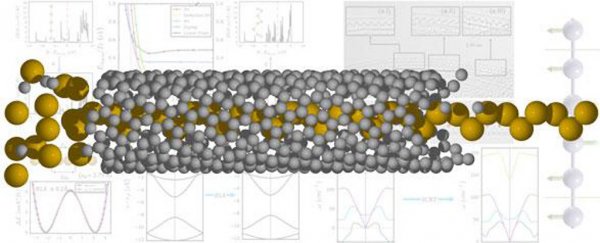Researchers have constructed the world's thinnest metallic nanowire, creating a stable string of the chemical element tellurium, that measures just one atom thick.
The team behind the nanowire says the material is the most precisely configured 'one-dimensional' system yet, and the technique used to produce the one-atom-thick atomic chain could lead to new advances in materials science and electronics miniaturisation.
While any structure based on elements from the periodic table actually occupies three dimensions in space, in the field of nano-scale materials such as nanowires, one-atom-thick structures are considered one-dimensional (1D) due to the arrangement of a single atom making up their height and width.
To build their own one-dimensional nanowire, a team led by researchers from the University of Cambridge in the UK produced the tellurium string inside extremely thin carbon nanotubes, which are hollow cylinders made up of carbon atoms.
According to the team, these nanotubes don't just provide a handy way of producing nanowires by confining the atomic string, but the enclosure provides a means of supporting the 1D structure inside them – and can also alter the tellurium's behaviour.
One of the problems with creating 1D structures is they can be very unstable, as the atoms that make up the nanowire are in a state of constant vibration, which can see the string lose its form or disintegrate.
By encapsulating the chemical you're working with, you can get around this problem, as long as the constraining substance doesn't introduce any unwanted side-effects.
"When working with materials at very small scales such as this, the material of interest typically needs to be deposited onto a surface, but the problem is that these surfaces are normally very reactive," says one of the team, materials scientist Paulo Medeiros.
"But carbon nanotubes are chemically quite inert, so they help solve one of the problems when trying to create truly one-dimensional materials."
Using carbon nanotubes with diameters ranging between 0.7 nanometres (nm) and 1.1 nm, the researchers were able to build tellurium nanowires approximately 10,000 times thinner than a human hair.
They also discovered that the properties of the chemical changed depending on how tightly enclosed the tellurium was inside the nanotubes.
Tellurium is a metalloid, which means as far as chemical elements go, it exhibits both metal-like and non-metal-like properties.
But when enclosed too tightly inside the nanotubes, it starts behaving more like a metal, and less like a semiconductor.
Knowing that limit could help scientists to one day find 1D-thick materials that can be used as the basis for even smaller transistors than what's currently been achieved, and might even be able to keep Moore's Law alive – which predicts that the number of transistors on a microchip will double every two years.
As for whether that will ultimately be possible, nobody knows for sure, but mastering the art of producing and manipulating 1D nanowires is likely to be our best shot at making it happen – although there's plenty of research to be done in the meantime.
"[W]e're just starting to understand the physics and chemistry of these systems," says Medeiros, "there's still a lot of basic physics to be uncovered."
The findings are reported in ACS Nano.
